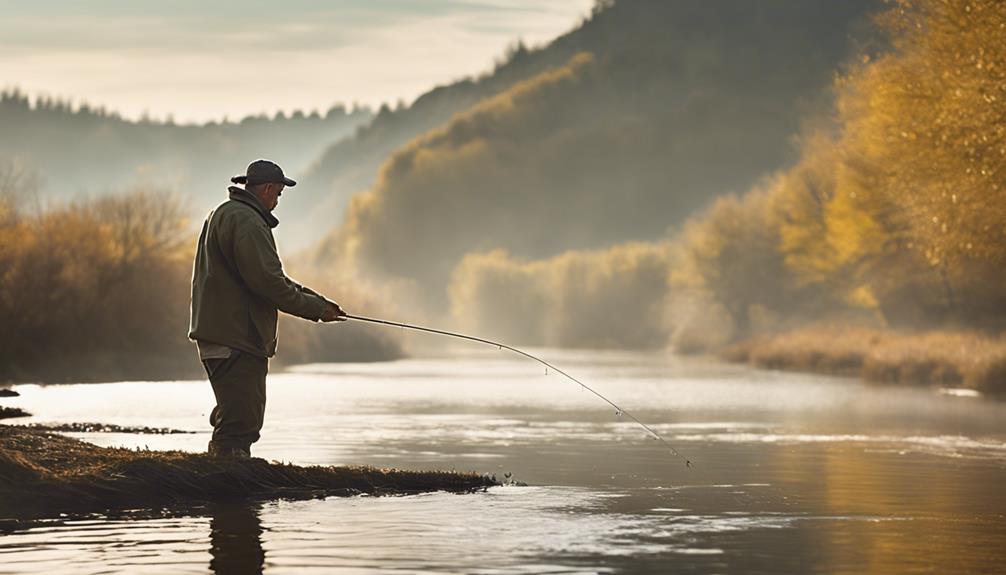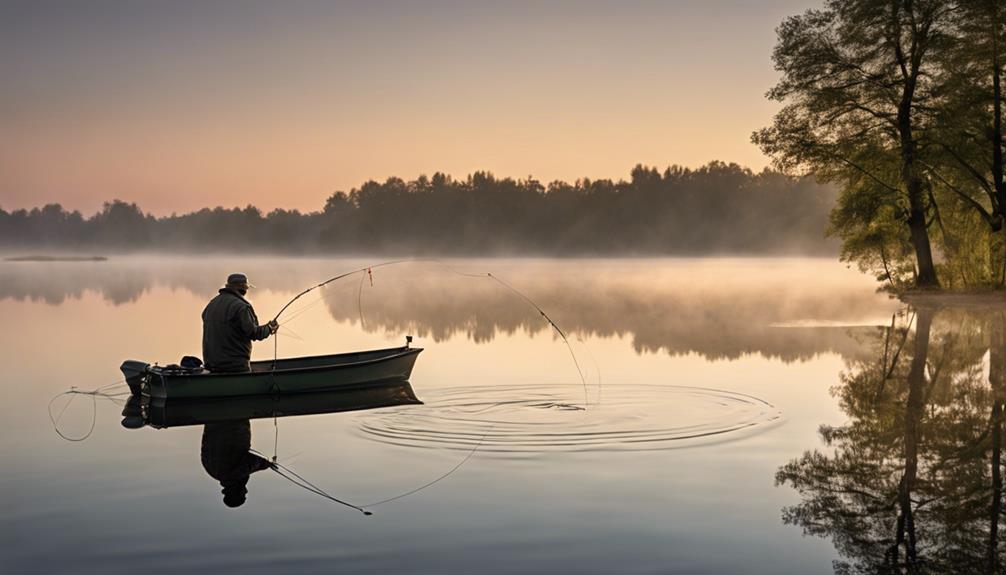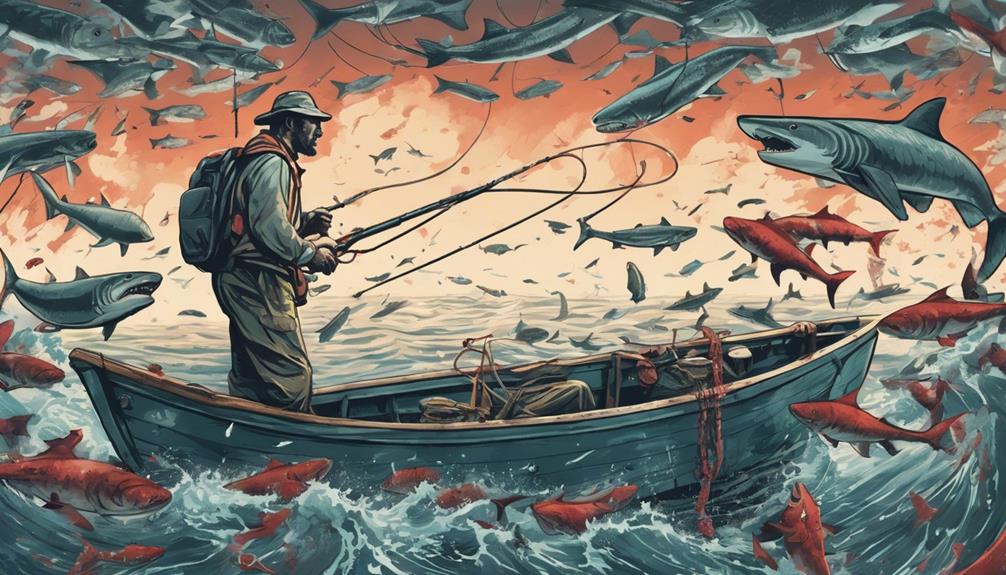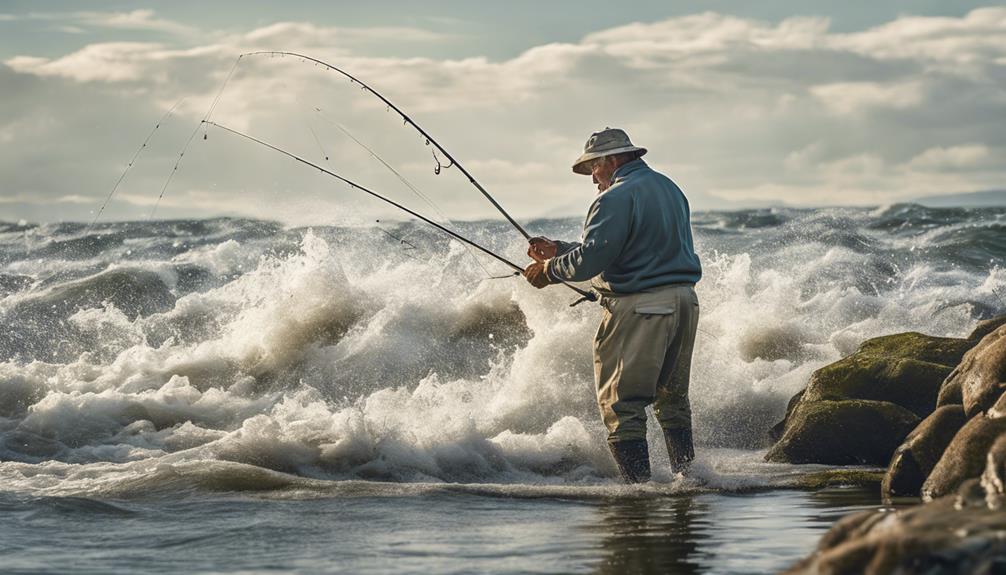Did you know that 85% of anglers agree that mastering river trout fishing techniques is crucial for a successful catch? Understanding the behavior of river trout and having the right equipment is just the beginning.
But why is honing your casting techniques and reading river currents so important? Well, let's explore how these skills can make all the difference between a day of frustration and a day of landing that prized trout you've been dreaming about.
Understanding River Trout Behavior
When fishing for river trout, observing their behavior can significantly enhance your chances of success. Understanding how trout feed and their preferred river habitat is crucial for a fruitful fishing experience. Trout are opportunistic feeders, constantly on the lookout for insects, small fish, or other food sources. By paying attention to their feeding patterns, you can select the right bait or lure to entice them effectively.
Trout are often found in areas of rivers where the current is moderate and there are plenty of hiding spots such as rocks, fallen trees, or overhanging vegetation. These spots provide them with protection from predators and easy access to food sources. When fishing in rivers, look for these habitats to increase your chances of encountering trout.
During different times of the day, trout exhibit varying feeding behaviors. They're most active during early morning and late afternoon when the light is low, making it easier for them to hunt. In contrast, trout are less likely to feed during the middle of the day when the sun is high and visibility is better. Adjusting your fishing schedule to align with their feeding times can lead to more successful catches.
Key Equipment for River Trout Fishing
To effectively fish for river trout, having the right equipment is essential. When gearing up for river trout fishing, consider the following key equipment factors:
- Rod Selection: Choose a rod that's appropriate for river fishing. Opt for a lightweight and flexible rod that allows for accurate casting in narrow river spaces. A rod length of 7 to 8.5 feet is ideal for most river trout fishing situations.
- Reel Maintenance: Keep your reel in top condition to prevent malfunctions while fishing. Regularly clean and lubricate the reel to ensure smooth operation. Check for any signs of wear and tear, and replace any damaged parts promptly.
- Line Weight and Leader Length: Select the appropriate line weight based on the size of trout in the river. Lighter lines around 2-6 pounds are suitable for smaller trout, while heavier lines up to 8-10 pounds are better for larger trout species. Additionally, adjust the leader length according to the clarity and depth of the water. Short leaders work well in clear water, while longer leaders are beneficial in deeper or murky waters.
Importance of Casting Techniques
Proper casting techniques play a crucial role in river trout fishing success, ensuring accurate presentation and enticing bites from wary trout. Precision casting is essential when targeting specific areas where trout are likely to hide, such as under overhanging branches or near rocks. By mastering precision casting, you can drop your lure with pinpoint accuracy, increasing the chances of a bite.
Distance accuracy is another key aspect of casting techniques that can make a significant difference in your fishing results. Trout are known for their wariness, especially in clear river waters, making it crucial to keep a safe distance. By honing your ability to cast at the right distance, you can avoid spooking the trout and ensure that your bait lands where they're more likely to strike.
To improve your casting techniques, practice regularly in different river conditions. Experiment with different casting angles and speeds to see what works best for you. Remember to consider factors like wind direction and current strength, as these can affect your casting accuracy. With dedication and practice, you can enhance your casting skills and increase your chances of a successful river trout fishing adventure.
Reading River Currents for Success
Mastering the art of reading river currents is essential for maximizing your success in trout fishing. To excel in this aspect, you must pay attention to crucial details such as water temperature analysis, spot selection tactics, weather pattern recognition, and current speed assessment.
- Water Temperature Analysis: Understanding how water temperature influences trout behavior is key. Trout are sensitive to temperature changes, so knowing the ideal temperature ranges can guide your fishing strategy.
- Spot Selection Tactics: Different sections of a river have varying currents and depths. Look for areas with slower currents, like eddies or pools, where trout often gather to conserve energy. Targeting these spots increases your chances of a successful catch.
- Weather Pattern Recognition and Current Speed Assessment: Recognizing how weather conditions affect river currents is vital. Rainfall can increase water flow and change current speeds, impacting trout feeding behavior. By assessing current speeds, you can adjust your fishing techniques accordingly to effectively present your bait to the fish.
Nymphing Vs. Dry Fly Techniques
When deciding between nymphing and dry fly techniques for river trout fishing, it's crucial to understand the distinct advantages and applications of each method.
Nymphing offers several advantages that make it a popular choice among anglers. One key advantage of nymphing is that it allows you to fish below the surface where trout often feed, increasing your chances of a successful catch. Nymphing also enables you to target specific feeding zones and reach deeper areas of the river where trout may be hiding. Additionally, nymphing can be more effective in fast-moving currents where dry flies may get dragged under quickly.
On the other hand, dry fly fishing presents its own set of challenges. One of the main challenges with dry fly fishing is that it requires more precision and skill to imitate insects floating on the water's surface convincingly. Trout can be selective when it comes to surface feeding, making it essential to present your dry fly in a natural and enticing manner. Furthermore, dry fly fishing may be less effective in high water conditions or when trout aren't actively rising to the surface to feed.
Mastering the Art of Drifting
To excel in river trout fishing, understanding the art of drifting is essential for effectively presenting your bait to the fish. Mastering the drift involves more than just letting your bait flow downstream; it's about perfecting presentation and precision to entice the trout into striking. Here are a few key points to consider:
- Perfecting presentation: Adjusting your drift to mimic the natural movement of insects on the water is crucial. Trout are selective feeders, so the more realistic your presentation, the higher your chances of success.
- Precision is key: Controlling the speed and depth of your drift is vital. Fine-tuning your float and control over the bait will help you target specific areas where trout are likely to be holding.
- Fine tuning float and control: Pay attention to the current speed and depth of the water to adjust your drift accordingly. Utilize mending techniques to avoid drag and ensure your bait drifts naturally.
Utilizing Proper Hook Setting Methods

Utilize proper hook setting methods to ensure a secure connection between your bait and the trout, increasing your chances of a successful catch. Proper hook setting is crucial in river trout fishing as it directly impacts your ability to hook the fish effectively. Understanding fish behavior is key to mastering this technique. Trout are known to be cautious and may exhibit a delicate bite, requiring a sensitive approach to hook setting.
When setting the hook, avoid jerking the line too forcefully as this can startle the fish, causing it to spit out the bait. Instead, opt for a smooth and swift motion once you feel the fish taking the bait. Remember, a slight movement of the rod tip can sometimes be enough to secure the hook in the fish's mouth.
It's essential to stay attentive and responsive to the fish's actions. If you sense any resistance or movement on the line, gently set the hook by smoothly pulling the rod tip upwards. This technique helps in establishing a solid connection without causing the fish to let go.
Strategies for Catching Trophy Trout
Enhance your chances of landing a trophy trout by honing your casting accuracy and precision. When targeting these prized fish, it's crucial to understand the specific strategies that can increase your success rate.
To catch trophy trout, consider the following tips:
- Trophy Trout Locations: Trophy trout are often found in deep pools or under overhanging structures where they can ambush prey. Look for areas with ample cover and where the current isn't too strong. These fish prefer cooler waters, so early mornings or late evenings can be prime times to target them.
- Effective Bait Choices: Opt for natural baits like live insects, minnows, or worms to attract trophy trout. Artificial lures such as spinners, spoons, or plugs can also be successful, especially if they mimic the local baitfish. Experiment with different bait sizes and colors to see what the trout in that specific location respond to best.
- Be Patient and Observant: Trophy trout are known to be cautious and selective feeders. Take your time to observe the water, look for any signs of fish activity, and adjust your approach accordingly. Avoid making sudden movements that could spook the fish and be prepared to wait for the perfect moment to make your cast.
Frequently Asked Questions
Can River Trout Fishing Techniques Be Applied to Other Types of Fishing, Such as Lake or Ocean Fishing?
When fishing in rivers for trout, your techniques like bait selection and casting accuracy are crucial. These skills can definitely be applied to other types of fishing, such as lake or ocean fishing.
Pay attention to rod sensitivity and fish movement, as they can help you adapt your river trout fishing techniques successfully. By honing these abilities, you can improve your overall fishing performance in various environments.
How Can Weather Conditions Affect River Trout Behavior and Fishing Success?
When fishing for river trout, weather conditions play a big role in their behavior and your success. Temperature fluctuations can affect their feeding patterns, making them more or less active.
Water clarity is also key since trout rely on sight to feed. Additionally, weather can impact their spawning behavior. Understanding how weather influences these aspects will help you adjust your techniques and improve your chances of catching more trout.
Are There Any Specific Regulations or Guidelines for River Trout Fishing That Anglers Should Be Aware Of?
When fishing for river trout, it's crucial to follow regulations and guidelines. These rules help with river conservation and ensure fishing ethics are upheld. Be aware of catch limits and fishing seasons to protect trout populations.
What Are Some Common Mistakes That Beginner Anglers Make When Trying to Catch River Trout?
When you're starting out with river trout fishing, common mistakes involve casting accuracy and bait selection. Not picking the right bait can turn the fish away, and inaccurate casting means they may not even notice your lure.
Remember to set your hook properly when you feel a bite – don't jerk it too hard. Lastly, patience is key; rushing can scare off the trout.
Master these basics for success on the river.
How Can Anglers Ensure the Sustainability of River Trout Populations While Still Enjoying the Sport of Fishing?
To ensure the sustainability of river trout populations while still enjoying fishing, practice ethical angling.
Follow catch-and-release guidelines, use barbless hooks, and handle fish with care. Respect regulations on bag limits and size restrictions. Avoid overfishing and protect trout habitats.
Conclusion
In conclusion, mastering the technique of river trout fishing is crucial for success. By understanding trout behavior, using the right equipment, perfecting your casting techniques, and reading river currents, you can increase your chances of catching trophy trout.
Whether you prefer nymphing or dry fly techniques, knowing how to drift your bait and set your hook properly are essential skills. With practice and dedication, you can become a skilled angler and reel in some impressive catches.
Happy fishing!



